ISS: SpaceX CRS-22 (International Space Station: SpaceX Commercial Resupply Service -22 Mission)
Non-EO
NASA
Mission complete
Quick facts
Overview
| Mission type | Non-EO |
| Agency | NASA |
| Mission status | Mission complete |
| Launch date | 03 Jun 2021 |
| End of life date | 10 Jul 2021 |
ISS: SpaceX CRS-22 (International Space Station: SpaceX Commercial Resupply Service -22 Mission)
Launch Payloads Mission Status References
NASA commercial cargo provider SpaceX is targeting 1:29 p.m. EDT, Thursday, June 3, 2021 to launch its 22nd commercial resupply services mission to the International Space Station. Liftoff will be from Launch Complex 39A at the agency’s Kennedy Space Center in Florida. SpaceX’s Dragon spacecraft will deliver new solar arrays to power future work aboard the orbiting laboratory, along with new science investigations, supplies, and equipment for the international crew. Live coverage will air on NASA Television, the NASA app and the agency’s website, with prelaunch events starting Wednesday, June 2. 1)
Dragon’s pressurized capsule will carry a variety of research, including an experiment that could help develop better pharmaceuticals and therapies for treating kidney disease on Earth, a study of cotton root systems that could identify varieties of plants that require less water and pesticides. The research also will include two model organism investigations: One will study bobtail squid to examine the effects of spaceflight on interactions between beneficial microbes and their animal hosts. The other will examine tardigrades’ adaptation to conditions in low-Earth orbit, which could advance understanding of the stress factors affecting humans in space.
The mission will include technology demonstrations, including a portable ultrasound device. Additionally, astronauts will test the effectiveness of remotely operating robotic arms and space vehicles using virtual reality and haptics interfaces.
Dragon’s unpressurized trunk section will deliver the first two of six new roll-out solar arrays based on a design tested on the space station in 2017. A robotic arm will extract them and astronauts will install them during a series of spacewalks this summer.
About 12 minutes after launch, Dragon will separate from the Falcon 9 rocket’s second stage and begin a carefully choreographed series of thruster firings to reach the space station. Arrival to the space station is planned for Saturday, June 5. Dragon will autonomously dock to the space-facing port on the station’s Harmony module, with Expedition 65 Flight Engineers Shane Kimbrough and Megan McArthur of NASA monitoring operations.
The spacecraft is expected to spend more than a month attached to the space station before it splashes down in the Atlantic Ocean, returning with research and return cargo.
Launch
The SpaceX CRS-22 (Commercial Resupply Services) mission was launched on 03 June 2021 at 17:29 UTC (1:29 EDT) on a Falcon 9 Block 5 vehicle from LC39A at KSC in Florida. - The Dragon separated from the rocket’s upper stage 12 minutes after liftoff. 2)
Orbit
Near circular orbit, altitude of ~ 400 km, inclination = 51.6º, period of~92 minutes.
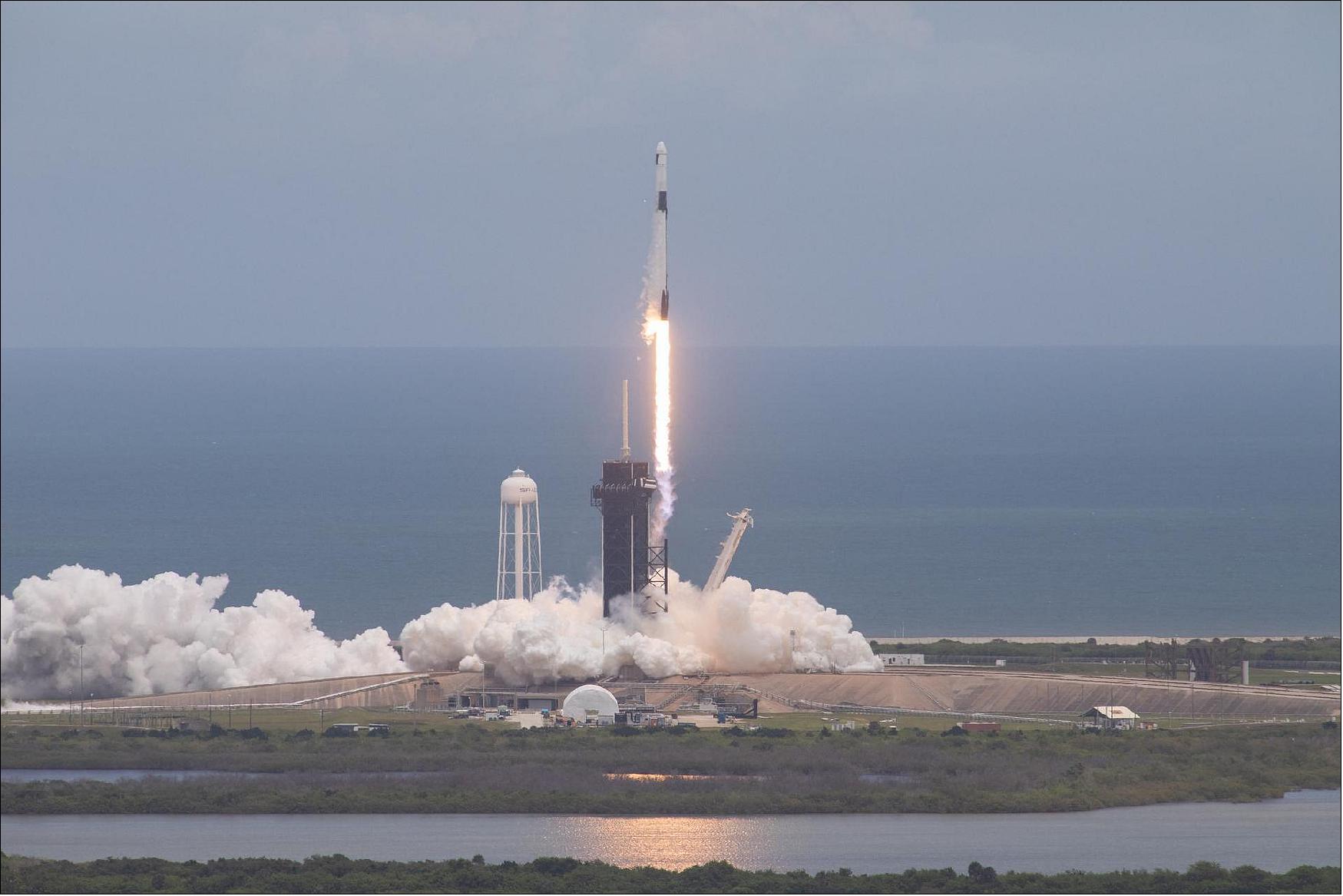
This launch was the first flight of a new booster, which made a successful droneship landing in the Atlantic Ocean. This was the first SpaceX launch to use a new booster since November 2020. “We’re actually surprised when we get to a mission like today’s where we’re flying a new booster,” said Sarah Walker, director of Dragon mission management at SpaceX, at the preflight briefing.
The Dragon spacecraft will arrive at the space station and autonomously dock to the space-facing port of the Harmony module on the International Space Station at approximately 5 a.m June 5. Coverage of the rendezvous and docking will begin at 3:30 a.m. NASA astronauts Shane Kimbrough and Megan McArthur will monitor the arrival of the spacecraft, which will stay aboard the orbiting laboratory for about a month before splashing down and returning critical science and hardware to teams on Earth.
The largest item the Dragon is transporting to the station is a pair of new solar arrays called the ISS Roll-out Solar Array (iROSA), developed by Redwire for ISS prime contractor Boeing. The arrays are stored in the Dragon’s trunk rolled up, and will be attached to the station’s truss and rolled out. Astronauts Shane Kimbrough and Thomas Pesquet are currently scheduled to conduct spacewalks on June 16 and 20 to install those arrays.
The arrays are the first two of six that will be installed on the station, overlaying part of the existing arrays. The higher efficiency of the new arrays means that, even by shadowing the existing arrays, they will still generate more power for the station.
The new solar arrays bring us back to a power generation that was the same as we had when we launched the older solar arrays,” said Joel Montalbano, NASA ISS program manager, during a June 2 briefing. “It allows us to continue the science and research programs we have on board.” He said that the new arrays will also provide enough power to support a commercial module being developed by Axiom Space that will be added to the station as soon as 2024.

Payloads
SpaceX’s 22nd contracted cargo resupply mission(CRS)to the International Space Station for NASA will deliver more than7,300pounds of science and research, crew supplies and vehicle hardware to the orbital laboratory and its crew. 4) 5)
Research Highlights
Hundreds of experiments are being conducted on the International Space Station in the areas of biology and biotechnology, physical sciences, and Earth and space science. This research helps us better understand how to prepare for future long-duration missions to the Moon and Mars, supports a growing space economy, and leads to developments that improve life on Earth. The SpaceX cargo spacecraft will deliver dozens of investigations to the International Space Station, including:
• Research that could help develop cotton varieties that require less water and pesticides
• An experiment looking at tardigrade survival in space, which could advance understanding of the stress factors affecting humans in microgravity
• A portable ultrasound device
• A new way of providing tactile and visual feedback to astronauts during robotic operations
• A look at interactions between beneficial microbes and their animal hosts
These and other cutting-edge investigations join the hundreds of ongoing experiments aboard the orbiting laboratory.
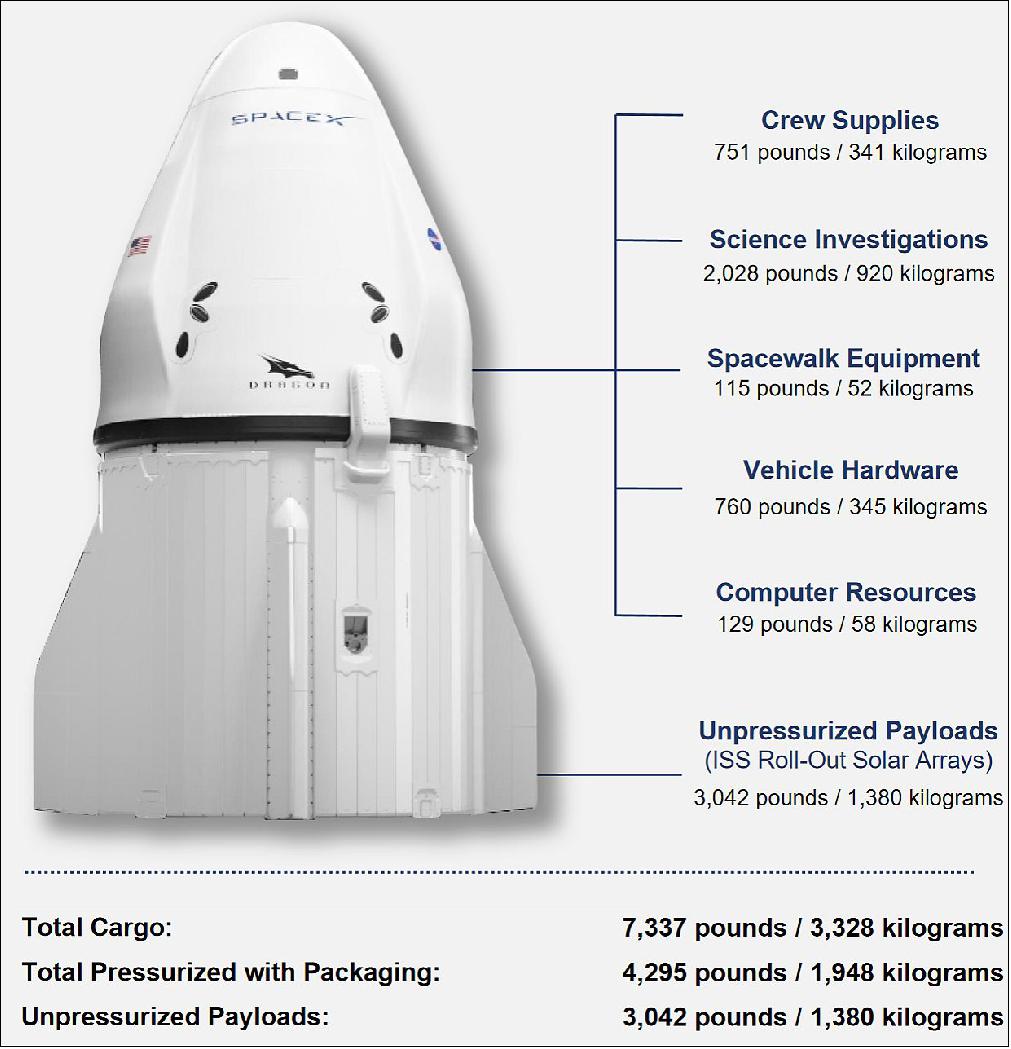
Launch of Hardware
• ISS Roll-Out Solar Arrays (IROSA) – Solar arrays launching for installation during the summer 2021 spacewalks to upgrade power capabilities on-orbit
• Catalytic Reactor - Legacy unit launching to provide critical sparing support for the water production capability for the environmental control and life support system (ECLSS)
• Commercial Crew Vehicle Emergency Breathing Air Assembly (CEBAA) Regulator Manifold Assembly (RMA) - Completing the first setup for emergency air supply capability, this integrated system supports as many as five crew members for up to one hour during an ISS emergency ammonia leak
• Zarya control module Kurs electronics unit - Critical hardware for cosmonaut remote-control docking of Russian spacecraft is launching to support planned maintenance activity during 2021
• Portable Water Dispense (PWD) Filter - Major filter assembly used to remove iodine from water consumed by the crew during nominal operations
• Commercial off-the-shelf (COTS) Air Tanks - Critical disposable air tanks to support gas resupply for routine cabin repress activities on-orbit
• Iceberg - Critical cold stowage capability to support expanded payload operations
Return of Hardware
• Catalytic Reactor Developmental Test Objective (DTO) - Developmental environmental control and life support system (ECLSS) unit returning for testing, teardown, and evaluation (TT&E) to determine the cause of failure and subsequent re-flight
• Urine Processing Assembly (UPA) Distillation Assembly - Critical ECLSS orbital replacement unit used for urine distillation, processing, and future use returning for TT&E and refurbishment to support future spares demand
• Sabatier Main Controller - Major Sabatier system hardware used in conjunction with the Oxygen Generation System (OGS) for water production needs on-orbit
• Rodent Research Habitats (AEM-X) - Habitats used during Rodent Research missions returning for refurbishment to support future missions in early 2022
• Nitrogen/Oxygen Recharge System (NORS) Recharge Tank Assembly (RTA) - Empty gas tanks returning for reuse to support high-pressure gas operations and activities on-orbit
Passenger CubeSat Payloads (ELaNa-36) on the SpaceX CRS-22 Mission
• Alpha, a 1U CubeSat technology demonstration mission of Cornell University, Ithaca, New York (deployment of a 1 x 1 m light sail with four tiny “chipsats” called Sprites attached)
• ARKSAT-1, a 1U CubeSat technology demonstration mission of the University of Arkansas, Fayettville, Arkansas (to demonstrate LEO-to-Earth atmospheric composition measurements using an on-board xenon flash bulb as the calibrated source for ground tracking)
• BeaverCube, a 3U CubeSat technology demonstration mission of MIT (Massachusetts Institute of Technology), Cambridge, MA
• CaNOP (Canopy Near-IR Observing Project), a 3U CubeSat of Carthage University, Kenosha, Wisconsin. The CaNOP science mission is to obtain medium-resolution images of global forest canopies with spectral resolution of 10 nm across the visible and near-infra-red.
• CAPSat (Cooling, Annealing, Pointing Satellite), a 3U CubeSat a technology demonstration mission of University of Illinois at Urbana–Champaign. Objective: CubeSat navigation and control.
• EagleSat-2, a 3U CubeSat mission of Embry–Riddle Aeronautical University, Daytona Beach, Florida. Objective: scientific investigation focused on detecting cosmic ray particles and studying the effects of solar radiation on various types of random access memory in a memory degradation experiment.
• PR_CuNaR2 (Puerto Rico CubeSat NanoRocks-2), a 3U CubeSat scientific investigation of the International American University of Puerto Rico - Bayamón Campus, Bayamón, Puerto Rico. The objective is to increase understanding of the outcomes of relevant collisions among millimeter-sized particles, or “pebbles”, in a protoplanetary disk.
• RamSat, a 2U CubeSat education mission of Oak Ridge Public Schools (Robertsville Middle School), Oak Ridge, Tennessee.
• Stratus, a 3U CubeSat science investigation mission of Michigan Technological University, Houghton, Michigan. The objective is of measuring cloud fraction, cloud top height, and cloud top wind with performance comparable to the best data obtained from NASA’s flagship Earth-observing spacecraft.
• SPACE HAUC (Science Program Around Communications Engineering with High Achieving Undergraduate Cadres ) , a 3U CubeSat (4 kg) of the University of Massachusetts Lowell, Lowell, Massachusetts. SPACE HAUC is an undergraduate student CubeSat project with the primary goal of providing multi-disciplinary undergraduate students with hands-on training in designing and building space-flight missions. SPACE HAUC's secondary mission is a technical demonstration of a high data -rate (up to 100 Mbit/s) X-band phased array system with adaptive beam steering capabilities.
• SOAR (Satellite for Orbital Aerodynamics Research), a 3U CubeSat technology demonstration mission of Manchester University, UK. The objective is to investigate the interaction between different materials and the atmospheric flow regime in very low Earth orbits (VLEO). Improving knowledge of the gas–surface interactions at these altitudes and identification of novel materials that can minimize drag or improve aerodynamic control are important for the design of future spacecraft that can operate in lower altitude orbits.
Mission Status
• June 20, 2021: NASA astronaut Shane Kimbrough and ESA (European Space Agency) astronaut Thomas Pesquet concluded their spacewalk at 2:10 p.m. EDT, after 6 hours and 28 minutes. In the eighth spacewalk of the year outside the International Space Station, the two astronauts completed the deployment of a new ISS Roll-Out Solar Array (iROSA) on the far end of the left (port) side of the station’s backbone truss structure (P6). 6)
- Kimbrough and Pesquet successfully unfolded the solar array, bolted it into place, and connected cables to the station’s power supply to complete deployment. Additionally, the astronauts removed and stowed hardware in preparation for releasing the second iROSA from the flight support structure for installation. The pair will work toward the second solar array upgrade – this one on the P6 truss’ 4B power channel – during another spacewalk, tentatively scheduled for June 25.
- NASA is augmenting six of the eight existing power channels of the space station with new solar arrays to ensure a sufficient power supply is maintained for NASA’s exploration technology demonstrations for Artemis and beyond as well as utilization and commercialization.
- This was the eighth spacewalk for Kimbrough, the fourth for Pesquet, and the fourth they have conducted together. Kimbrough has now spent a total of 52 hours and 43 minutes spacewalking, and Pesquet’s total spacewalking time is 26 hours and 15 minutes.

• June 20, 2021: Astronauts Thomas Pesquet and Shane Kimbrough floated outside the International Space Station Sunday to deploy and unroll a new solar array blanket after encountering spacesuit glitches and an interference issue during a previous excursion Wednesday. 7)
- Pesquet and Kimbrough switched their spacesuits to battery power at 7:42 a.m. EDT (11:42 GMT) Sunday to begin a planned six-and-a-half hour spacewalk.
- The astronauts moved from the space station’s Quest airlock to the far port, or left, side of the lab’s solar power truss. Once in place, Pesquet and Kimbrough completed tasks they started during Wednesday’s spacewalk.
- The astronauts lost time while ground teams evaluated an issue with the controls and display module on Kimbrough’s suit Wednesday. Then mission control discussed momentary glitch with a sublimator, part of the cooling system on Kimbrough’s suit.
- The astronauts continued the spacewalk Wednesday and moved a new iROSA (ISS Roll-Out Solar Array), unit from a temporary mounting fixture to the far port side of the station’s truss. Once at the P6 solar array work site, the astronauts attached the iROSA to a mounting fixture installed on a preparatory spacewalk earlier this year, then attempted to unfold the unit like a book.
- But the astronauts ran into some interference as they tried to unfold the iROSA unit. With Pesquet and Kimbrough already running behind schedule due to the earlier spacesuit issues, mission control called it quits and told the astronauts to head back inside the space station.
- The spacewalk Sunday was originally planned to install a second iROSA solar array on the other side of the P6 truss. But after losing time on the previous spacewalk, Pesquet and Kimbrough had to catch up with the work left undone Wednesday.
- Kimbrough, a former U.S. Army helicopter pilot, swapped spacesuits for Sunday’s excursion after the troubles with his suit Wednesday.
- The ISS has eight power channels, each fed with electrical power generated from one solar array wing extending from the station’s truss backbone. The original solar panels launched on four space shuttle missions from 2000 to 2009.
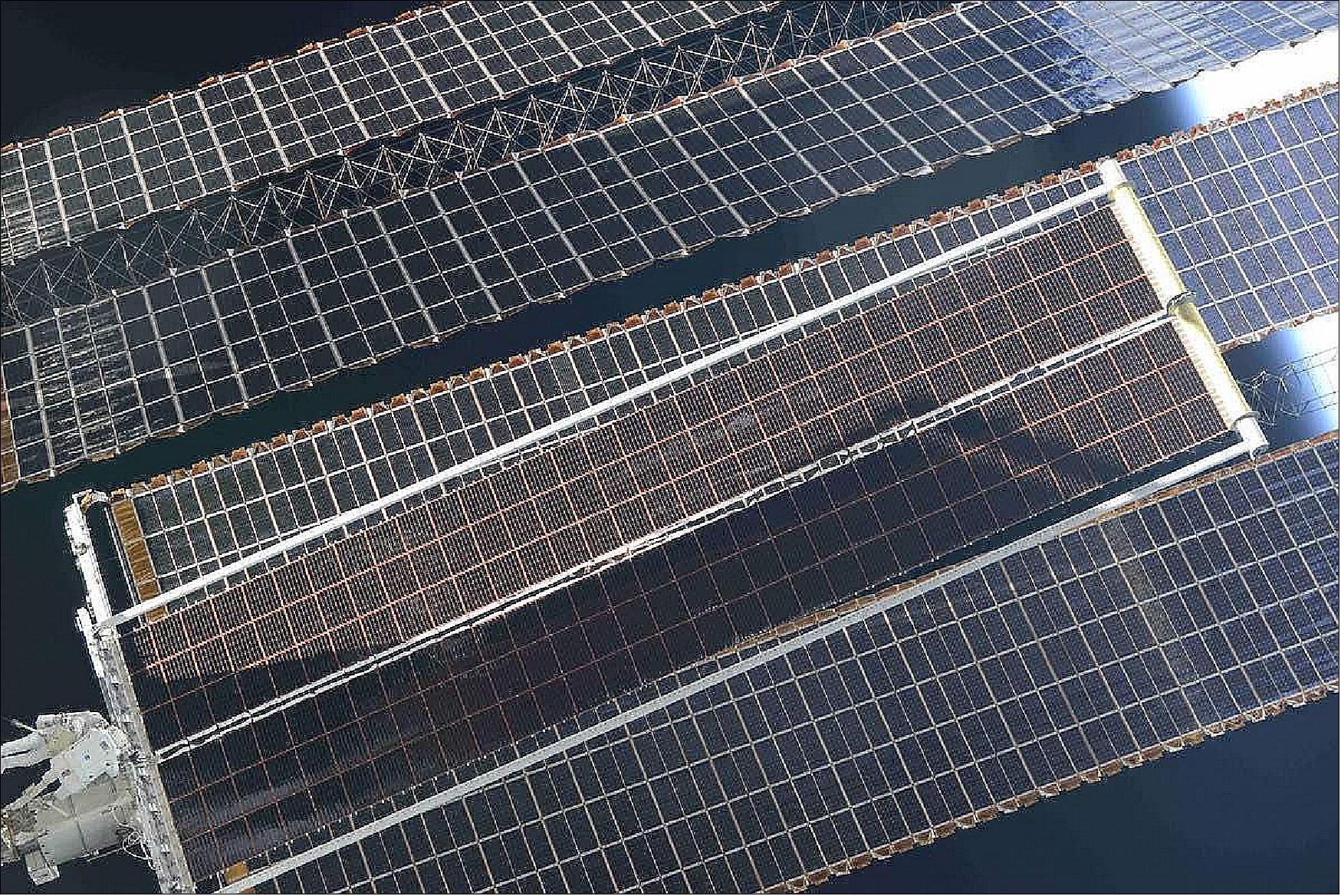
- As expected, the solar panel efficiency has degraded over time. NASA is upgrading the space station’s power system with the new roll-out solar arrays, which will partially cover six of the station’s eight original solar panels.
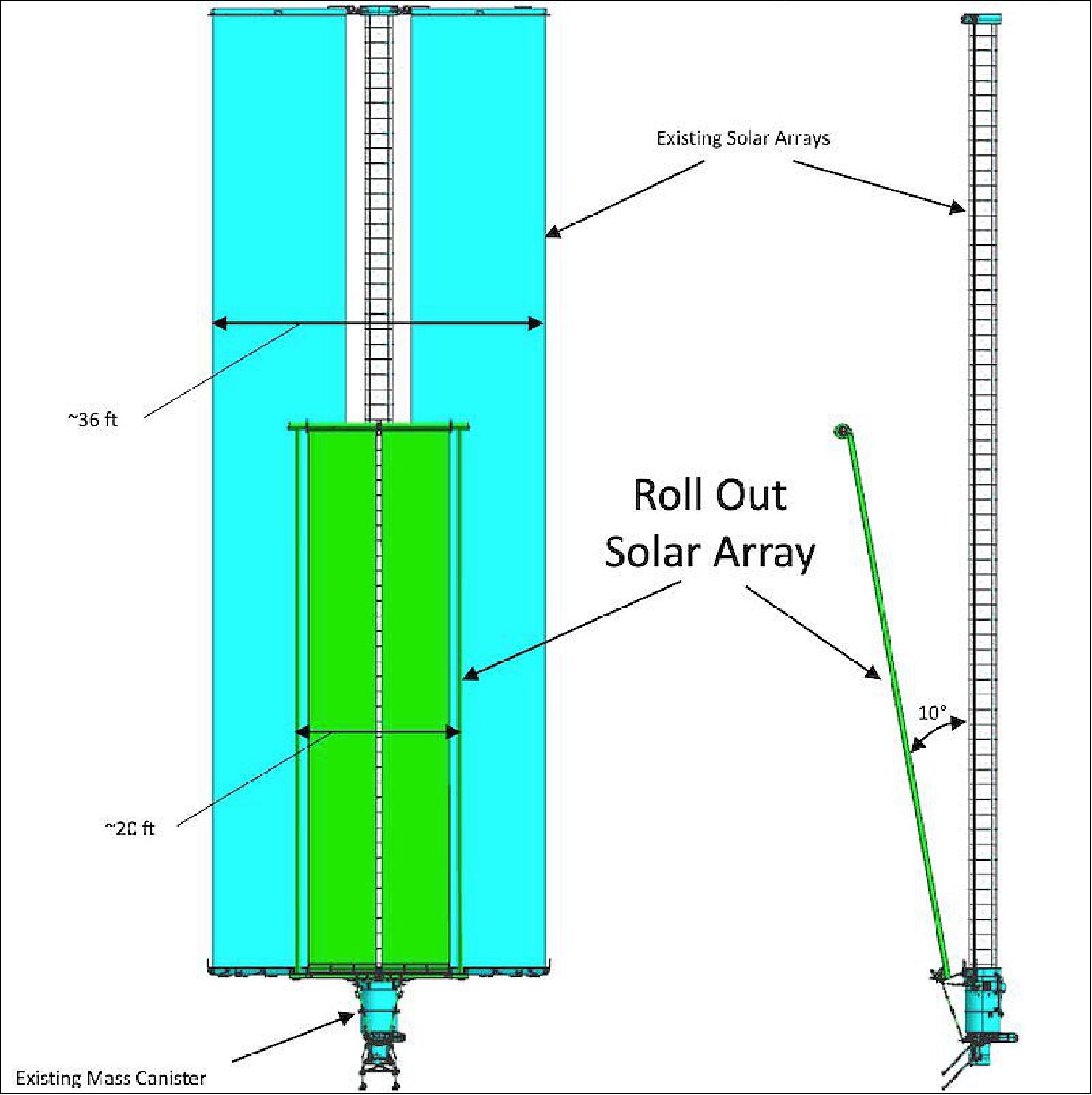
- When all six iROSA units are deployed on the station, the power system will be capable of generating 215 kW of electricity to support at least another decade of science operations. The enhancement will also accommodate new commercial modules planned to launch to the space station.
- The first pair of iROSA wings will go on the oldest solar panel module — named P6 — on the far left, or port, side of the space station. They launched to the space station on a SpaceX Cargo Dragon capsule earlier this month. The new solar arrays were supplied to NASA by Boeing, Redwire, and a team of subcontractors.
- Fully deployed, the roll-out solar arrays stretch 63 feet long and 20 feet wide (19 x 6 meters), about half the length and half the width of the station’s current solar arrays. Despite their smaller size, each of the new arrays will generate about the same amount of electricity as each of the station’s existing solar panels.
- A mounting bracket plugs the new arrays into the station’s power channels and rotary joints, which keep the solar wings pointed at the sun as the spacecraft races around Earth at more than 17,000 mph.
- Early on in Sunday’s spacewalk, Pesquet and Kimbrough separated the two parts of the iROSA fixture on the 2B power channel at the P6 truss segment. The astronauts drove bolts to secure the array in place, then mated power cables to connect the new array to the space station’s electrical grid.
- The cables were mated when the space station was flying over the night side of the Earth, when the old P6 solar array was not generating any power. Then the astronauts released clamps keeping the roll-out solar array spooled in its launch configuration.
- Beginning at 11:24 a.m. EDT (15:24 GMT), the array gradually unrolled using strain energy in the composite booms supporting the solar blanket. The design of the deployment mechanism eliminates the need for motors to drive the solar array.
- The carbon fiber support booms were rolled back against their natural shape for storage during launch.
- After about 10 minutes, the iROSA blanket reached its full length of 63 feet.
- “Good news, you two,” Canadian astronaut Jenni-Sidey Gibbons radioed the spacewalkers from mission control in Houston. “You can probably can see most of what we can see. We’re tracking a full and good deploy of that solar array, so well done both of you.”
- Pesquet then adjusted tensioning bolts to secure the iROSA blanket in place.
- The astronauts then headed back in-board on the space station’s truss to prep a second iROSA unit, which Pesquet and Kimbrough will move to the P6 truss segment during a spacewalk tentatively scheduled for Friday, June 25.
- The astronauts will connect the second iROSA unit to the 4B power channel on the opposite side of the P6 truss from the blanket they deployed Sunday. If all goes well on Friday’s excursion, they will repeat the steps they accomplished Sunday to unroll the second iROSA blanket.
• June 16, 2021: NASA astronaut Shane Kimbrough and ESA (European Space Agency) astronaut Thomas Pesquet concluded their spacewalk at 3:26 p.m. EDT, after 7 hours and 15 minutes. In the seventh spacewalk of the year outside the International Space Station, the two astronauts installed a new ISS Roll-Out Solar Array (iROSA) into its mounting bracket on the far end of the left (port) side of the station’s backbone truss structure (P6). 8)
- Kimbrough and Pesquet successfully removed the array from its position in the flight support equipment and maneuvered it into position on the mast canister at the 2B power channel.
- Before the new array can be deployed and begin providing power to the orbiting laboratory, spacewalkers will need to install the electrical cables and drive the final two bolts to enable the solar array to unfurl its fully deployed position. Pesquet and Kimbrough are scheduled for another spacewalk coming up on Sunday, June 20 to continue the installation of new solar arrays.
- NASA is augmenting six of the eight existing power channels of the space station with new solar arrays to ensure a sufficient power supply is maintained for NASA’s exploration technology demonstrations for Artemis and beyond as well as utilization and commercialization.
- This was the seventh spacewalk for Kimbrough, the third for Pesquet, and the third they conducted together. Kimbrough has now spent a total of 46 hours and 15 minutes spacewalking, and Pesquet’s total spacewalking time is 19 hours and 47 minutes.
- Space station crew members have conducted 239 spacewalks in support of assembly and maintenance of the orbiting laboratory. Spacewalkers have now spent a total of 62 days, 18 hours, and 28 minutes working outside the station.
- In November 2020, the International Space Station surpassed its 20-year milestone of continuous human presence, providing opportunities for unique research and technological demonstrations that help prepare for long-duration missions to the Moon and Mars and also improve life on Earth. In that time, 244 people from 19 countries have visited the orbiting laboratory that has hosted nearly 3,000 research investigations from researchers in 108 countries and areas.
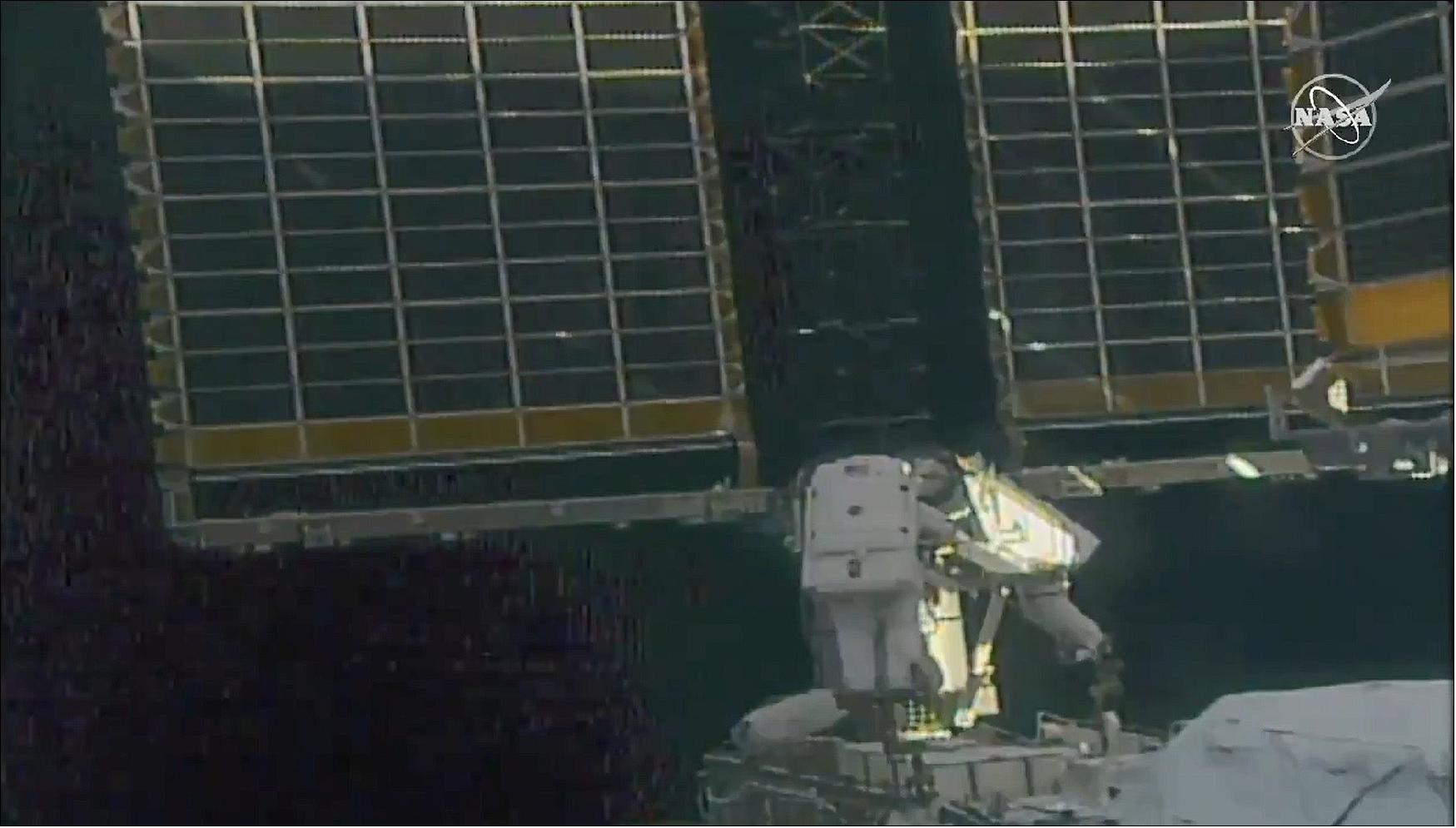
• June 8, 2021: The Expedition 65 crew members are helping researchers today understand how living in space affects the human body. Two astronauts are also getting ready for a pair of spacewalks while the SpaceX Cargo Dragon continues being unpacked at the International Space Station. 9)
- NASA Flight Engineer Mark Vande Hei joined Commander Akihiko Hoshide of the Japan Aerospace Exploration Agency (JAXA) for vein scans using electrodes and the Ultrasound-2 device on Tuesday. The duo took turns scanning each other’s heart, neck, shoulder and leg veins for the Vascular Echo study that investigates cardiovascular health in space.
- Vande Hei later assisted NASA Flight Engineer Megan McArthur unloading a variety of cargo delivered aboard the SpaceX Cargo Dragon. The duo started the day with the rest of their crewmates, including astronauts Shane Kimbrough and Thomas Pesquet and cosmonauts Oleg Novitskiy and Pyotr Dubrov, reviewing safety procedures necessary while Dragon is docked at the station.
- Kimbrough and Pesquet continue gearing up for two spacewalks planned for June 16 and 20 to install a new pair of solar arrays recently delivered in the Cargo Dragon’s unpressurized trunk. The duo first checked out spacesuit helmet cameras and lights then reviewed their spacewalk procedures using specialized 3-D software today.
- Over in the orbiting lab’s Russian segment, Roscosmos Flight Engineers Oleg Novitskiy and Pyotr Dubrov explored ways to improve exercise in space to maintain crew health. The duo later completed reconfiguring the Poisk module where last week’s seven-hour and 19-minute spacewalk was staged.
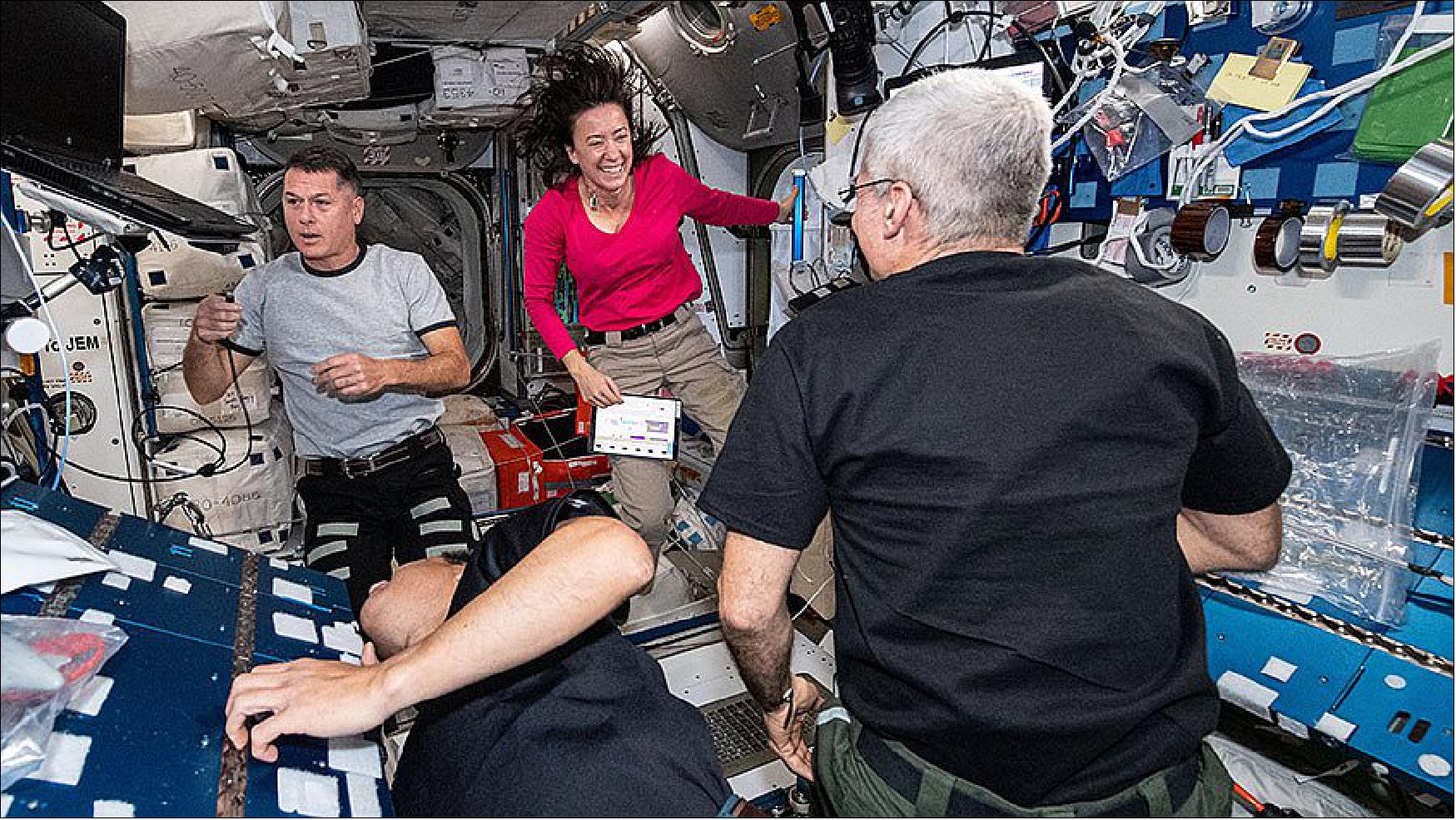
• June 8, 2021: ESA astronaut Thomas Pesquet and NASA astronaut Megan MacArthur run sessions on the Pilote experiment proposed by France’s space agency CNES in the European Columbus module of the International Space Station. 10)
- Continuing French neuroscience experiments started on the Russian space station Mir, the Pilote experiment evaluates a new way of providing tactile and visual feedback to astronauts when operating robots. Using a virtual reality headset and a haptic joystick can recreate the feeling of pressure and touch when tele-operating a robotic arm.
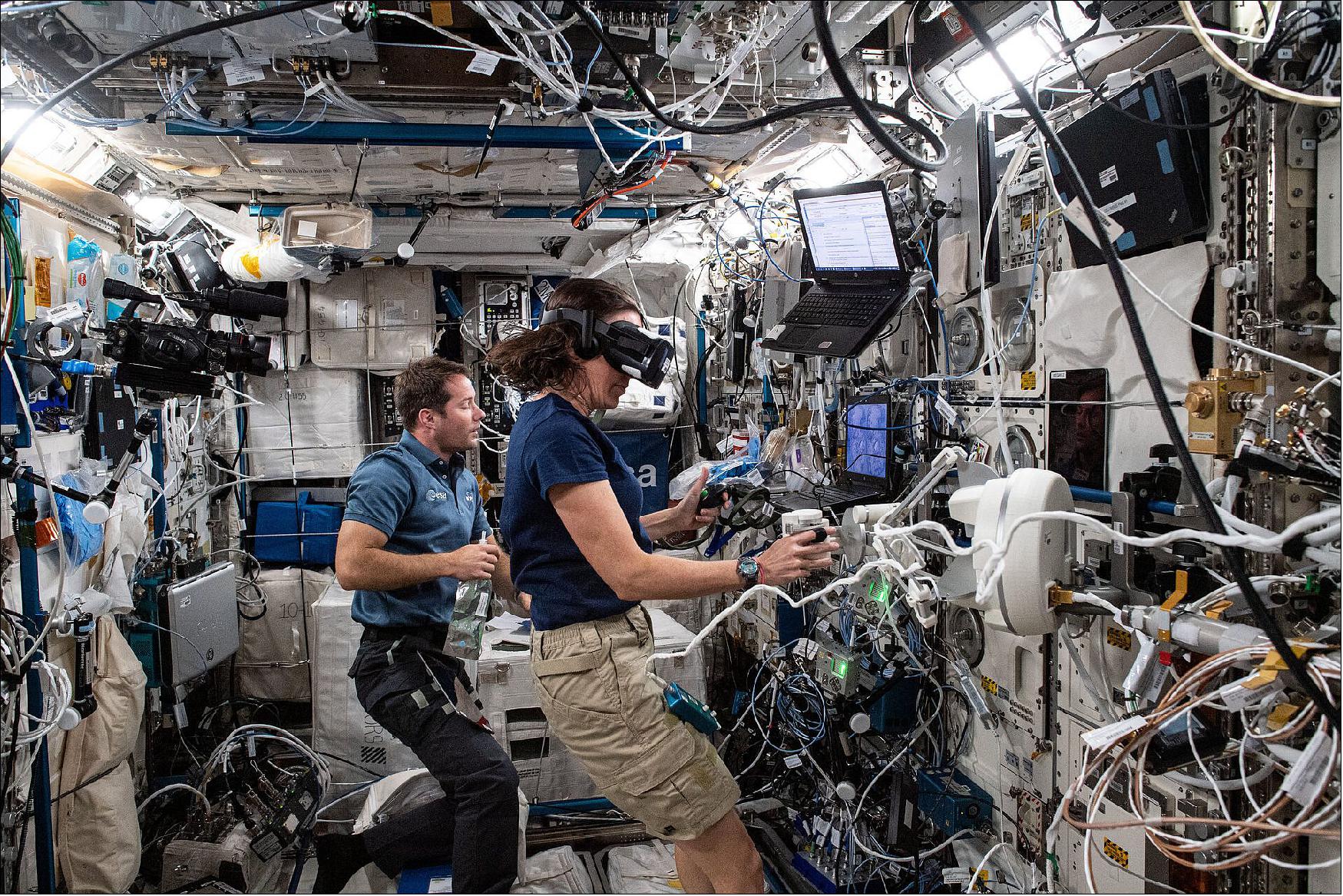
• June 7, 2021: The SpaceX Cargo Dragon resupply ship is open for business at the International Space Station following its automated docking early Saturday. Now, the Expedition 65 crew turns its attention to a pair of U.S. spacewalks to upgrade the orbiting lab’s power system. 11)
- Flight Engineer Megan McArthur and Commander Akihiko Hoshide worked throughout Monday unpacking and activating science experiments delivered Saturday aboard the SpaceX Cargo Dragon. The U.S. space freighter launched from Kennedy Space Center on Thursday carrying over 7,300 pounds of new science, supplies and solar arrays to replenish the orbiting lab.
- McArthur started the day transferring research hardware from Dragon to begin work for the Kidney Cells-02 study that seeks to improve treatments for kidney stones and osteoporosis. She followed that up configuring MERLIN and POLAR science freezers containing biological samples inside Dragon.
- Hoshide removed mice launched aboard Dragon and placed them inside a habitat in the Kibo laboratory module to study space-caused aging-like symptoms such as bone loss and muscle atrophy. NASA Flight Engineers Shane Kimbrough and Mark Vande Hei assisted the duo with the cargo transfers throughout Monday.
- Kimbrough and Flight Engineer Thomas Pesquet partnered together Monday afternoon readying the U.S. Quest airlock and their U.S. spacesuits for two spacewalks set for June 16 and 20. The experienced spacewalkers, who had two spacewalks together in 2017 during Expedition 50, will work both days to install the first two of six new solar arrays on the space station’s integrated truss structure. Robotics controllers will soon command the Canadarm2 robotic arm to extract the new pair of solar arrays from Dragon’s trunk and stage it in time for the installation spacewalks.
- Cosmonauts Oleg Novitskiy and Pyotr Dubrov spent the morning testing satellite navigation gear, studying space exercise and replacing orbital plumbing gear. The duo then wrapped up stowing and inventorying the tools they used during a seven-hour and 19 minute spacewalk on June 2.
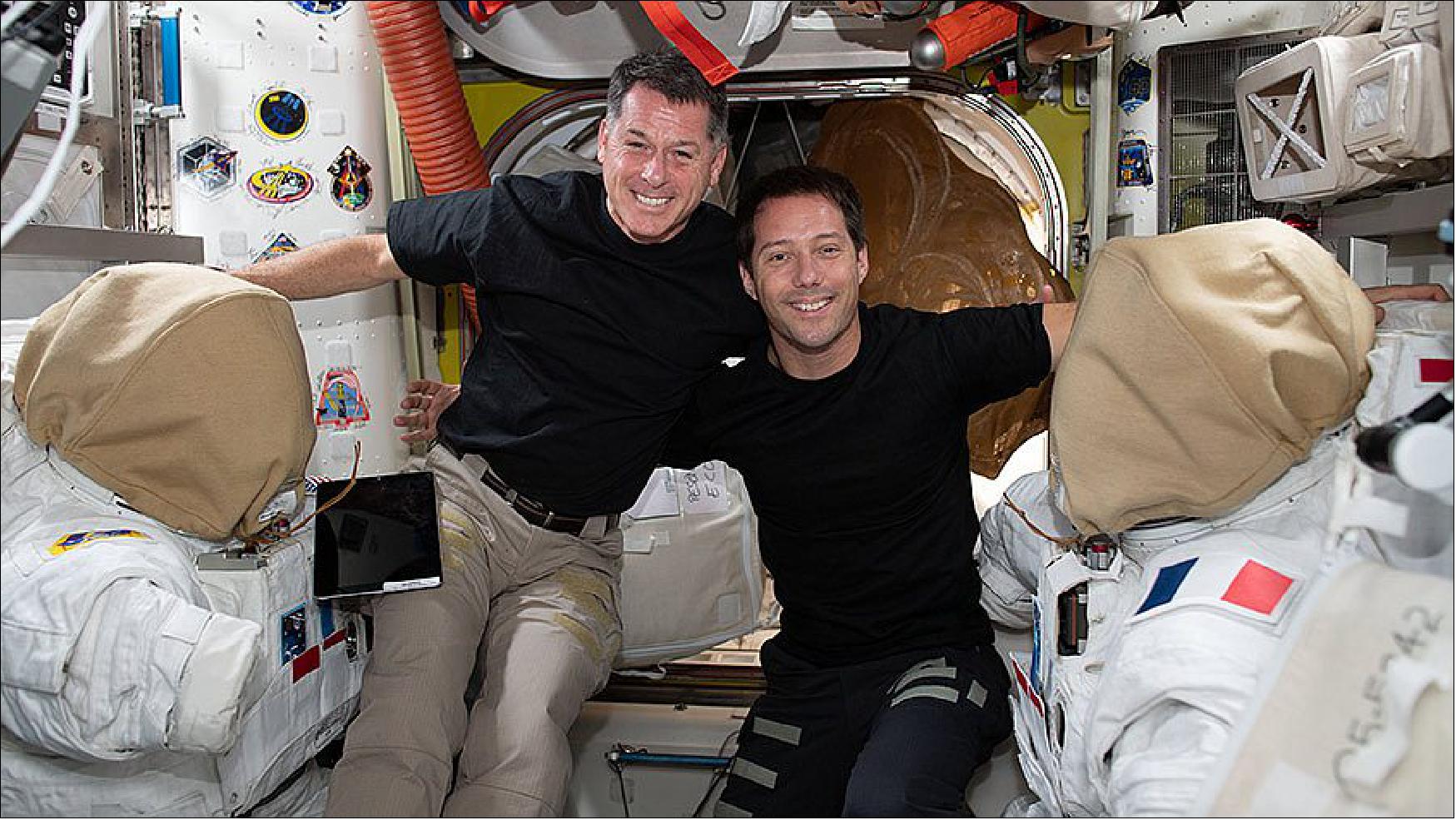
• June 5, 2021: While the International Space Station was traveling more than 250 miles (400 km) over the South Pacific ocean, a SpaceX Dragon cargo spacecraft autonomously docked to the space-facing side of the orbiting laboratory’s Harmony module at 5:09 a.m. EDT, Saturday, June 5. NASA astronauts Shane Kimbrough and Megan McArthur were monitoring docking operations for Dragon. 12)
- This 22nd contracted resupply mission for SpaceX delivers the new ISS Roll-out Solar Arrays (iROSA) to the space station in the trunk of the Dragon spacecraft. The robotic Canadarm2 will extract the arrays and astronauts will install them during spacewalks planned for June 16 and 20.
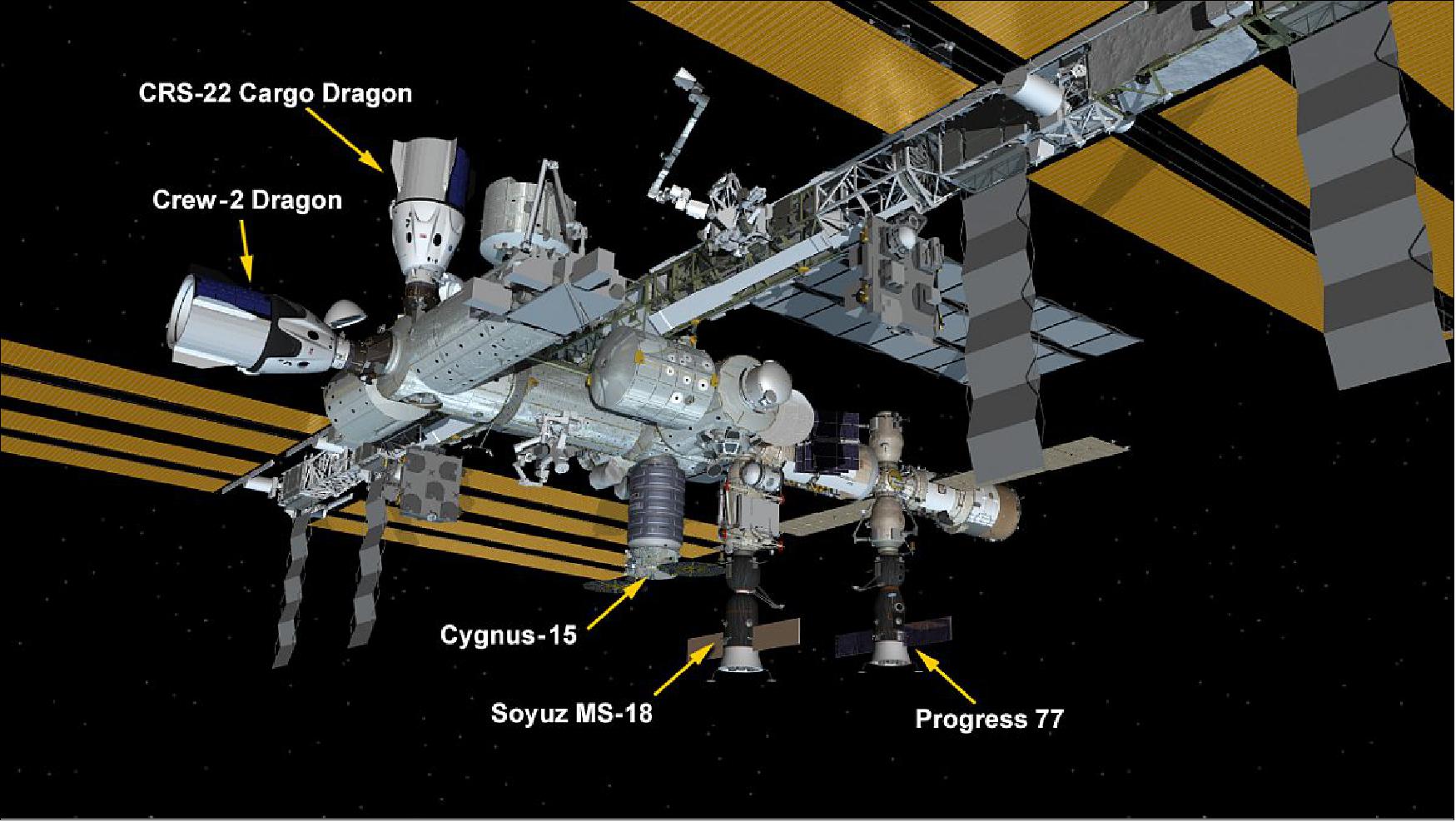
Among the science experiments Dragon is delivering to the space station are (Ref. 12):
- Symbiotic squid and microbes: The Understanding of Microgravity on Animal-Microbe Interactions (UMAMI) study uses bobtail squid and bacteria to examine the effects of spaceflight on interactions between beneficial microbes and their animal hosts. This type of relationship is known as symbiosis. Beneficial microbes play a significant role in the normal development of animal tissues and in maintaining human health, but gravity’s role in shaping these interactions is not well understood. This experiment could support the development of measures to preserve astronaut health and identify ways to protect and enhance these relationships for applications on Earth.
- Producing tougher cotton: Cotton is used in many products, but its production uses significant amounts of water and agricultural chemicals. The Targeting Improved Cotton Through On-orbit Cultivation. (TICTOC) study focuses on improving cotton’s resilience, water-use, and carbon storage. On Earth, root growth depends upon gravity. TICTOC could help define which environmental factors and genes control root development in microgravity. Scientists could use what they learn to develop cotton varieties that require less water and pesticide use.
- Water bears take on space: Tardigrades, also known as water bears for their appearance when viewed under a microscope, are creatures that can tolerate extreme environments. The Cell Science-04 experiment aims to identify the genes involved in water bear adaptation and survival in these high-stress environments. The results could advance scientists’ understanding of the stress factors that affect humans in space. 13)
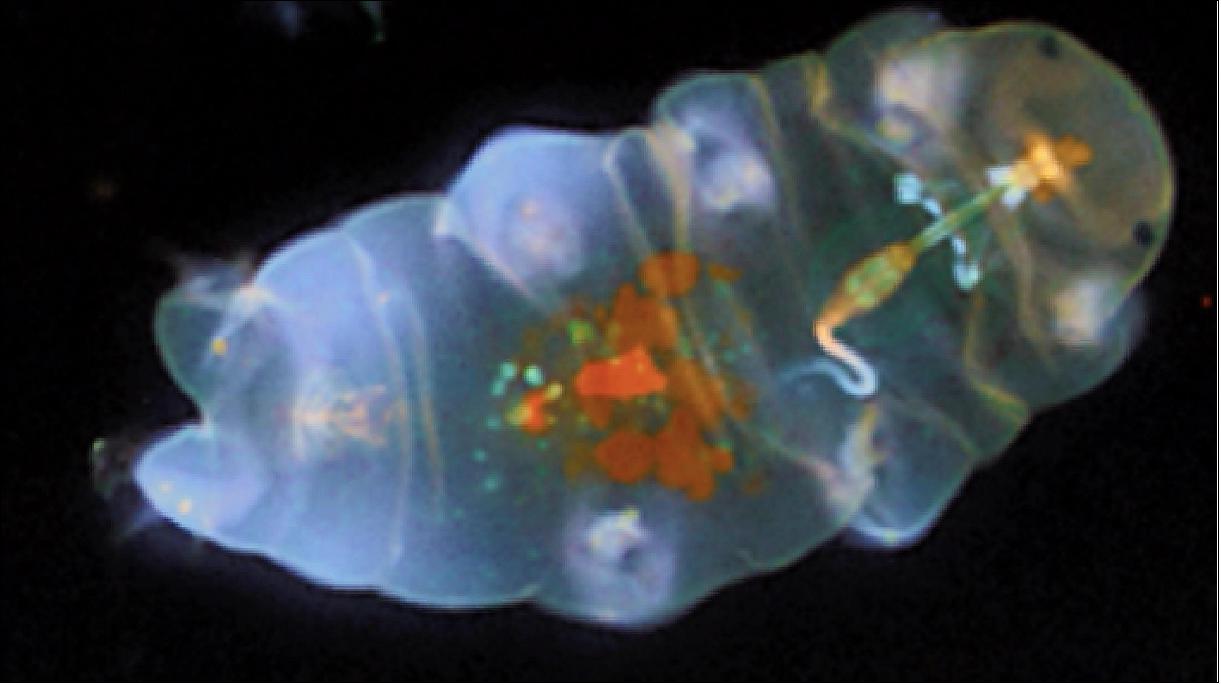
- On-the-spot ultrasound: The handheld, commercial Butterfly IQ Ultrasound device could provide critical medical capabilities to crews on long-term spaceflights where immediate ground support is not an option. This study will demonstrate the use of an ultrasound unit alongside a mobile computing device in microgravity. Its results have potential applications for medical care in remote and isolated settings on Earth.
- Developing better robot drivers: An ESA (European Space Agency) investigation, Pilote, test the effectiveness of remotely operating robotic arms and space vehicles using virtual reality and haptic interfaces. Pilote studies existing and new technologies in microgravity by comparing those recently developed for teleoperation to those used to pilot the Canadarm2 and Soyuz spacecraft. The study also compares astronaut performance in using the interfaces on the ground and during spaceflight. Results could help optimize workstations on the space station and future space vehicles for missions to the Moon and Mars.
- Bonus power: New solar panels headed to station are made up of compact sections that roll open like a long rug. The ISS Roll-out Solar Arrays (iROSA) are based on a previous demonstration of roll-out panels performed on station. They are expected to provide an increase in energy available for research and station activities. NASA plans a total of six new arrays to augment the station’s power supply with the first pair launching on this flight. The Expedition 65 crew is scheduled to begin preparations for spacewalks to supplement the station’s existing rigid panels this summer. The same solar array technology is planned to power NASA’s Gateway in lunar orbit.
- These are just a few of the hundreds of investigations currently being conducted aboard the orbiting laboratory in the areas of biology and biotechnology, physical sciences, and Earth and space science. Advances in these areas will help keep astronauts healthy during long-duration space travel and demonstrate technologies for future human and robotic exploration beyond low-Earth orbit to the Moon and Mars through Artemis.
ISS-Upgrade of Solar Arrays
NASA will start an upgrade this year of the solar arrays of the International Space Station to ensure the station has sufficient power to continue operating at least through the end of the decade. 14)
NASA announced on Jan. 11,2021 it would fly the first pair of upgraded solar arrays to the station later this year on a SpaceX Dragon cargo spacecraft, stored in the spacecraft’s unpressurized trunk section. Two other pairs of the arrays will fly on later Dragon cargo missions, but NASA did not disclose a schedule for them.
The arrays will be installed on top of six of the eight existing solar arrays on the station. Doing so allows the new arrays to use the tracking and power distribution systems of the existing arrays, minimizing the amount of new equipment needed. Each array will require two spacewalks to prepare the location where the arrays will be installed, and then to do the installation itself.

That installation means the new arrays will partially shadow the old ones, covering a little more than half of each array. However, the new arrays are more efficient, producing more power than what will be lost by covering the old arrays. NASA estimates that, when all six new arrays are installed, the overall power system will generate 215 kW of power, compared to 160 kW the existing arrays provide.
The new arrays will use a technology called Roll Out Solar Arrays (ROSA), developed by Deployable Space Systems. The solar arrays are rolled up in a canister and then unfurled, or rolled out, once in space. The ROSA system was tested on the ISS in 2017 and is now being incorporated into other spacecraft, such as the Power and Propulsion Element of NASA’s lunar Gateway.
NASA installed the existing set of eight arrays on shuttle missions from 2000 to 2009. The performance of the arrays has been gradually degrading, as expected. The ISS Advisory Committee identified that degradation in 2018 as one issue for the long-term future of the ISS.
NASA is currently authorized to operate the ISS through 2024, although there have been several efforts in Congress to formally authorize an extension of operations through the end of the decade. The agency seeks to eventually shift to commercial space stations, although its LEO (Low Earth Orbit) commercialization initiative has been hindered by a lack of funding, including just $17 million in fiscal year 2021 compared to its request for $150 million.
Boeing, NASA’s ISS prime contractor, is optimistic that the station can operate for years to come with the new solar arrays, as well as other work on its power system and upgrades to its communications system to increase its bandwidth.
Boeing will support the ISS growing research capabilities and commercial opportunities with new solar arrays to increase the orbiting laboratory’s power supply. The modification to Boeing’s ISS sustainment contract with NASA calls for Boeing to deliver six additional solar arrays to NASA for installation beginning in 2021. 15)
The new 19 meter x 6 meter arrays will together produce more than 120 kW of electricity from the sun’s energy, enough to power more than 40 average U.S. homes. Combined with the eight original, larger arrays, this advanced hardware will provide a 20 to 30 percent increase in power, helping to maximize the station’s capabilities for years to come. The arrays will provide ISS with electricity to sustain its systems and equipment, plus augment the electricity available to continue a wide variety of public and private experiments and research in the station’s unique microgravity environment.
“When it comes to game-changing research and technological development, the space station is currently hitting its full stride,” said John Mulholland, ISS vice president and program manager for Boeing. “These arrays, along with other recent upgrades to the station’s power system and data-transfer speed, will ensure that ISS remains an incubator and business model in the commercial space ecosystem for the coming decades. Access to this unique lab will continue to pay off as researchers study the challenges of future deep-space exploration and make discoveries that improve life on Earth.”
Most of the ISS systems, including its communications systems, batteries and scientific equipment racks, have been upgraded since humans began a continuous presence on the orbiting laboratory in November 2000. Two International Docking Adapters, manufactured by Boeing, have been attached to the ISS to allow commercial spacecraft to dock autonomously to the station. Boeing is the prime contractor for ISS sustainment; the company’s studies have determined that the ISS could safely operate beyond 2030 if NASA and its international partners choose to do so.
Deployable Space Systems of Santa Barbara, California, will produce the structure of the new arrays, including the canister and frame that will unfurl to hold the solar-array blankets in place. Deployable Space Systems also built the canister, frame and solar array blanket for a prototype of the new arrays that was successfully tested aboard the ISS in June 2017.
Spectrolab, a Boeing company based in Sylmar, California, produces the arrays’ XTJ (NeXt Triple Junction) Prime solar cells of Spectrolab, which will be some of the most powerful ever launched into space. They are the same solar cells that power Boeing's CST-100 Starliner spacecraft in flight and while docked to the ISS. Spectrolab also produced the station’s original solar cells, as well as the solar cells tested on the prototype.
“The XTJ Prime space solar cells are much more efficient than any of their predecessors and are fit to support the cutting-edge research being done aboard the International Space Station,” said Tony Mueller, president of Spectrolab.
References
1) Kathryn Hambleton, Stephanie Schierholz, Megan Cruz, Leah Cashier, ”NASA Sets Coverage, Invites Public to Virtually Join Next Cargo Launch,” NASA Press Release M21-067, 26 May 2021, URL: https://www.nasa.gov/press-release/nasa-sets-coverage-invites-public-to-virtually-join-next-cargo-launch
2) Jeff Foust, ”Falcon 9 launches cargo Dragon mission to ISS,” SpaceNews, 03 June 2021, URL: https://spacenews.com/falcon-9-launches-cargo-dragon-mission-to-iss/
3) Danielle Sempsrott, ”SpaceX’s 22nd Cargo Resupply Mission Underway as Dragon Journeys to Station,” NASA, SpaceX, 3 June 2021, URL: https://blogs.nasa.gov/spacex/2021/06/03/
spacexs-22nd-cargo-resupply-mission-underway-as-dragon-journeys-to-station/
4) Brian Dunbar, ”SpaceX CRS-22Mission Overview,” NASA, 28 May 2021, URL: https://www.nasa.gov/content/spacex-22-mission-overview
5) Melissa Gaskill, ”SpaceX’s 22nd Commercial Resupply Mission to Space Station Launches Water Bears, Squid, Solar Panels,” NASA Space Station Research, 20 May 2021, URL: https://www.nasa.gov/mission_pages/station/research/news/spacex-22-research-highlights
6) Mark Garcia, ”Spacewalkers Complete First Roll Out Solar Array Installation,” NASA Space Station, 20 June 2021, URL: https://blogs.nasa.gov/spacestation/2021/
06/20/spacewalkers-complete-first-roll-out-solar-array-installation/
7) Stephen Clark, ”Spacewalkers unfurl first of six new space station solar arrays,” Spaceflight Now, 20 June 2021, URL: https://spaceflightnow.com/2021/06/20/us-eva-75/
8) Mark Garcia, ”Spacewalk to Install First New Solar Array Concluded,” NASA Space Station, 16 June 2021, URL: https://blogs.nasa.gov/spacestation/2021/
06/16/spacewalk-to-install-first-new-solar-array-concluded/
9) Mark Garcia, ”Human Research, Spacewalk Preps as Dragon Cargo Ops Continue,” NASA Space Station, 8 June 2021, URL: https://web.archive.org/web/20210608192001/https://blogs.nasa.gov/spacestation/2021/06/08/human-research-spacewalk-preps-as-dragon-cargo-ops-continue/
10) ”Pilotes,” ESA Science & Exploration, 08 June 2021, URL: https://www.esa.int/ESA_Multimedia/Images/2021/06/Pilotes
11) Mark Garcia, ”Astronauts Unload Dragon, Prep for Two U.S. Spacewalks,” NASA Space Station, 7 June 2021, URL: https://web.archive.org/web/20210607151612/https://blogs.nasa.gov/spacestation/2021/06/07/astronauts-unload-dragon-prep-for-two-u-s-spacewalks/
12) Norah Moran, ”SpaceX Cargo Craft Docks to Station,” NASA Space Station, 5 June 2021, URL: https://blogs.nasa.gov/spacestation/2021/06/05/spacex-cargo-craft-docks-to-station/
13) ”Small Packages with Big Benefits Aboard SpX-22,” NASA Science, June 22, 2021, URL: https://science.nasa.gov/science-news/biological-physical/small-packages-with-big-benefits-aboard-spx-22
14) Jeff Foust, ”NASA to upgrade space station solar arrays,” SpaceNews, 11 January 2021, URL: https://spacenews.com/nasa-to-upgrade-space-station-solar-arrays/
15) ”Boeing to Provide Six More Solar Arrays for International Space Station,” Boeing Press Release, 11 January 2021, URL: https://boeing.mediaroom.com/news-releases-statements?item=130801
The information compiled and edited in this article was provided by Herbert J. Kramer from his documentation of: ”Observation of the Earth and Its Environment: Survey of Missions and Sensors” (Springer Verlag) as well as many other sources after the publication of the 4th edition in 2002. - Comments and corrections to this article are always welcome for further updates (eoportal@symbios.space).